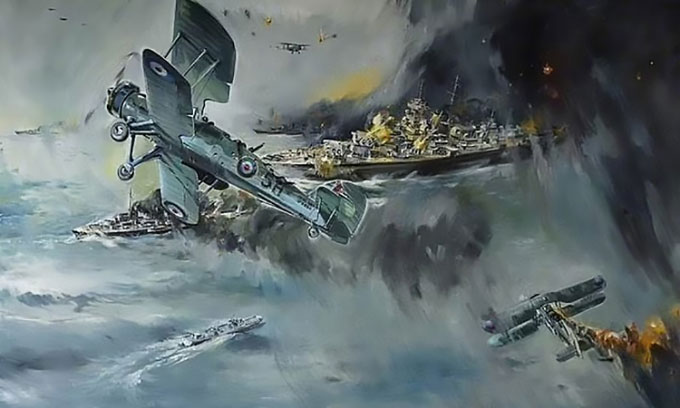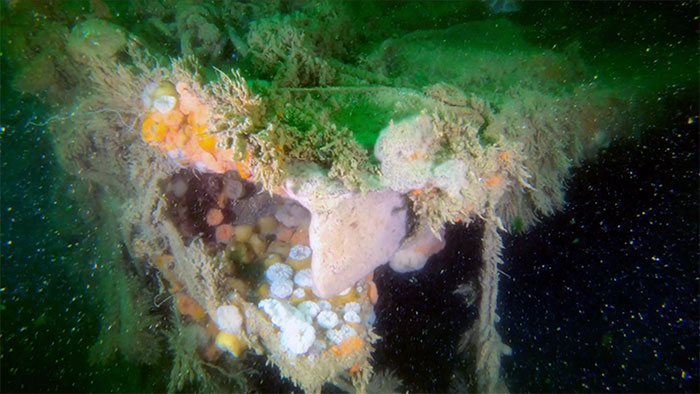The V-1302 John Mahn shipwreck, sunk in the North Sea over 80 years ago, is still leaking explosives and toxic substances into the water.
The wreck of the V-1302 John Mahn lies on the seabed of the North Sea. (Video: VLIZ)
According to a new study published on October 18 in the journal Frontiers in Marine Science, the hazardous pollutants from the sunken ship continue to affect the microbial community as well as the geochemical characteristics of the nearby seabed.
“The public is often quite interested in shipwrecks due to their historical value, but their potential environmental impact is frequently overlooked,” said study author Josefien Van Landuyt, a biological engineer and microbiologist at Ghent University in Belgium.
The wreck of the V-1302 John Mahn, located in the North Sea off the coast of Belgium, is just one of thousands of ship and aircraft wrecks scattered along the seabed. The vessel originally operated as a German fishing boat but was later requisitioned by the German Navy during World War II as a patrol ship.
On February 12, 1942, six Hawker Hurricane aircraft from the Royal Air Force, while patrolling the Belgian coast, attacked the V-1302 John Mahn. Two aerial bombs struck the ship, causing it to sink rapidly and resulting in the loss of 11 crew members, along with the vessel’s cargo of munitions and coal reserves, which sank to the seabed.

Simulation of the bombing that sank the V-1302 John Mahn in 1942. (Photo: Fleet Air Arm Museum).
Van Landuyt’s team studied the potential impacts of this shipwreck as part of the North Sea Wrecks project. The project’s goal is to investigate the shipwrecks lying on the seabed of the North Sea, which borders Belgium, Norway, Denmark, the Netherlands, the UK, and Germany—all of which were involved in World War II.
Researchers estimate that globally, shipwrecks from both World Wars contain between 2.5 million and 20.4 million tons of petroleum products. They hope the data collected by the project will assist policymakers in determining the best steps to address shipwrecks in the North Sea and protect its ecosystem.
The research team analyzed samples from the steel hull of the ship as well as the surrounding sediment. They also collected samples from various locations around the wreck at different directions and distances to assess the extent of the pollution.
Samples revealed numerous heavy metals such as nickel and copper, as well as arsenic and various explosive compounds. Polycyclic aromatic hydrocarbons (PAHs), natural chemicals found in gasoline, coal, and crude oil, were also detected.
The research team noted that they found the highest concentrations of metals near the coal hold of the V-1302 John Mahn, but these metals were also present in sediment deposited behind the wreck. The samples containing the most chemicals were also located close to the ship.
The wreckage has impacted the microbial community surrounding the ship. The research team identified Rhodobacteraceae and Chromatiaceae, bacteria that degrade PAHs, in sediment samples with the highest levels of pollution. The sulfate-reducing bacteria Desulfobulbia were also identified in samples taken from the ship’s hull, potentially contributing to its corrosion.

The wreckage has affected the microbial community surrounding the ship.
“Although shipwrecks can act as artificial reefs and hold significant historical storytelling value, we should not forget that they are hazardous man-made objects inadvertently introduced into the natural environment. Nowadays, sunken ships are raised for that reason,” Van Landuyt added.
In addition to shipwrecks, the North Sea contains up to 1.6 million tons of munitions such as shells and bombs dumped after each World War. These explosives, along with other chemical warfare agents, can be toxic to marine life. Petroleum products are also known to affect the development, reproduction, and feeding of marine organisms.
This study only included analyses of the V-1302 John Mahn shipwreck, but Van Landuyt emphasized the need for more sampling of various wrecks at different locations to gain a broader understanding of their impact on the North Sea.


















































